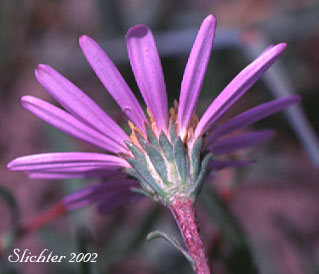
 The photo at right shows a close-up of the involucre of alpine aster from
along the north loop road above Kiger Gorge, Steens Mt., southeastern Oregon........July
17, 2000.
The photo at right shows a close-up of the involucre of alpine aster from
along the north loop road above Kiger Gorge, Steens Mt., southeastern Oregon........July
17, 2000.
Alpine aster is a delightful and well behaved aster for the home rockery or front of a border. The stems are ascending to decumbent, measuring from 3-40 cm long. The herbage ranges from glabrous to densely covered with minute hairs below the flower heads. The leaves are mainly in a basal cluster with a few much-reduced leaves on the stems. The basal leaves are 2-10 cm long, 1-15 mm wide, and 3-5 veined. They are linear to linear-oblanceolate in shape tapering to the petioles. The margins are entire.
The flower heads are solitary atop the stems. There are 10-40 lavender to violet or occasionally white ray flowers measuring from 7-15 mm long. The involucres are 5-13 mm high with the bracts layered like shingles and often with purplish margins (See upper photo.) The margins of the bracts are often lined with minute hairs. The central disk flowers are yellow.
Variety alpigenus has basal leaves which are largely oblanceolate with obtuse to rounded tips. The largest leaves are usually greater than 5 mm wide and may measure up to 15 cm long and 15 mm wide. The stems are up to 20 cm tall.
Alpine aster is a wildflower of open slopes from subalpine to alpine habitats
Aster alpigenus is found from Washington south to California, and eastward to western Montana, western Wyoming and northeastern Nevada.
Varieties:
Variety alpigenus may be found in the Olympic and Cascade Mts. south to about latitude 44 degrees in Deschutes County in Oregon. It is also found in the Wallowa Mts. of northeastern Oregon as wellas in the Olympic Mts of northwest Washington. The plants of this variety have are large and oblanceolate in shape, measuring up to 15 cm long and from 5-15 mm wide. The plants measure from 20-30 cm high.
Variety haydenii is found from the Wallowa and Blue Mts of northeastern Oregon and the Steens Mt. in southeastern Oregon east to the mountains of central idaho, western Montana, and western Wyoming. It is also found in Elko County, Nevada. The plants of this variety are smaller with stems occasionally up to 15 cm tall and smaller linear or linear-elliptic leaves up to 10 cm long and 3 mm wide.
Variety andersonii is found in the southern Cascade Mts of Oregon, south through the Sierra Nevada to the mountains of southern California. Its range extends westward to the Pacific Ocean in southwestern Oregon. The plants of this variety are often robust in growth, having stems up to 40 cm high with leaves up to 25 cm long and 13 mm wide.